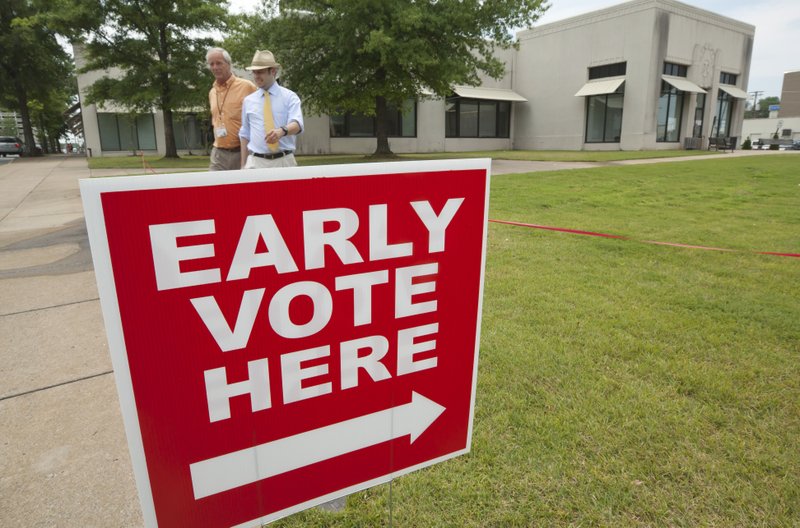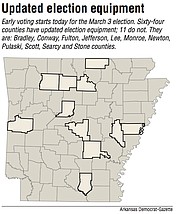With today’s start of early voting in the March 3 elections, voters in 10 Arkansas counties will be using new equipment purchased by Secretary of State John Thurston with state and local funds, officials in those counties said.
Sixty-four of the state’s 75 counties now have voting equipment that is either new this year or purchased in the past several years.
“If you have any problems, we are going to have enough people there [to help voters],” said Saline County Clerk Doug Curtis, who is in one of the 10 counties. “But we don’t perceive any problems with the equipment.”
“All the training is done,” Curtis said Sunday in an interview at the voting center in Benton, across the street from the Saline County Courthouse. “We have an early-voting crew set up here, but we will have some of our election workers come in and work during early voting, where they will be familiarized with everything [so] we don’t have much confusion in what they are supposed to be doing.”
Of the 10 counties, Saline County has the largest number of registered voters — 73,595, based on figures from the secretary of state’s office.
The other nine counties are Baxter, Drew, Lincoln, Madison, Mississippi, Phillips, Poinsett, St. Francis and Van Buren, according to officials in those counties.
“I think we are going to have a trial and error,” Phillips County Election Commission Chairman Wayne Boals said about the new equipment.
“People are going to look at the machines and be terrified,” he said last week. “[But] after people see how it goes, they are going to love it.” Phillips County has 10,384 registered voters, according to the secretary of state’s office.
Madison County Clerk Tamitha Blocker said, “We have tested everything thoroughly.
“Everything is working, so I’m pretty confident we’ll have a good election,” she said last week. Madison County has 9,715 registered voters, according to the secretary of state’s office.
Thurston, a Republican from East End, secured the new equipment through Nebraska-based Election Systems & Software with the help of state funding made available under Act 808 of 2019, as well as funding from most of those counties.
That law diverted $8.4 million in excess funds from the property tax relief trust fund to the county voting systems grant fund. (Act 808 also increased the homestead property tax credit from $350 to $375 per parcel.)
About $2 million was used to reimburse three counties — Benton, White and Ashley — for half of what they previously paid for new equipment.
Fifty-four counties had updated equipment by the November 2018 general election.
About $9.7 million from the secretary of state’s budget, $4.4 million in federal funds and $8.7 million from the counties paid for this equipment under deals brokered by then-Secretary of State Mark Martin’s office, officials for Martin said in 2018.
In the March 3 primary elections, the 11 counties that won’t have updated equipment are Bradley, Conway, Fulton, Jefferson, Lee, Monroe, Newton, Pulaski, Scott, Searcy and Stone counties.
Officials in Scott and Pulaski counties said they expect to have new equipment in time for the Nov. 3 general election. Pulaski County has the most registered voters in the state, with 249,002, according to the secretary of state’s office.
Curtis said Saline County’s new equipment includes 188 Express Vote electronic machines into which a voter inserts a paper ballot and touches the screen to pick candidates.
Then, the voter receives a paper listing his or her choices. The voter puts the paper into one of the county’s 28 new DS 200 tabulating machines for the ballot to be counted.
This new voting equipment in Saline County largely replaces the equipment purchased by then-Secretary of State Charlie Daniels’ office in 2006 with federal funds, Curtis said.
“We’ve had two elections with these [new] machines,” Curtis said, adding there were no problems.
The new machines in Saline County were used in Hot Springs Village in the Dec. 10 special primary election for the state House District 22 seat — formerly held by Rep. Mickey Gates, R-Hot Springs — and in the Jan. 14 millage increase election in Harmony Grove, Curtis said.
He said he expects anywhere from 16,000 to 20,000 Saline County voters to cast ballots in the March 3 elections. Those elections include the Democratic and Republican primaries and the nonpartisan general election. Candidates include those for president, legislative seats, judgeships, school boards, quorum courts and constables. Some cities and counties have ballot issues — bond issues, sales tax proposals and annexation — and there are some school millage changes.
“We don’t have a whole lot of local elections,” Curtis, a Republican, said of Saline County.
“We have the judicial [races], but for the Republican primary, there is not hardly anything that is on there,” he said. “I think the Republicans are going to get out and vote for [President Donald] Trump.”
This is the second consecutive presidential election primary in which the state is holding its election in conjunction with a number of other states.
The state has 1.73 million registered voters, according to records in the secretary of state’s office.
The secretary of state’s office won’t have a projection for turnout in the March 3 elections, Thurston spokesman Chris Powell said in a written statement.
“Usually, general election turnout is fairly consistent, however — about 50% in off-years and around 65% in presidential years,” he said.
Voter turnout for the primary in previous presidential election years was 38% in 2016 and 22% in 2012, Powell said. In 2008, the presidential primary election was held in February, separate from the rest of the party primaries held in May. In 2008, the presidential primary election’s turnout was 34%, according to the secretary of state’s website, and the May turnout was 18%.
Voter turnout for the midterm primary elections dating back to 2006 were as low as 19% in 2018 and as high as 29% in 2010, he said.
Early voting
Early voting in the March 3 election begins today. State law sets early voting hours as 8 a.m. to 6 p.m. Monday-Friday and 10 a.m. to 4 p.m. Saturday. Early voting ends at 5 p.m. March 2. Some locations may have different voting hours. Information about where and when to vote is available by contacting county clerks or county election commissions. Ballot information and voter-registration status are available at voterview.org or from county officials.


